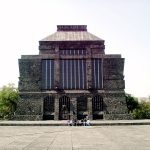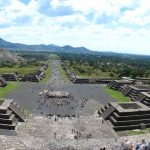
El yacimiento arqueológico de Mixcoac ha estado habitado desde la época teotihuacana (400-600 e. c.). Los tepanecas llegaron a la zona después del año 900 de nuestra era. Las ruinas que se pueden ver hoy en día son todas de esta última etapa de ocupación. Situado en la orilla del lago de Texcoco, más tarde se convirtió en un importante lugar religioso y de devoción para los mexicas de la Triple Alianza.
Sólo se conserva una pequeña parte del asentamiento prehispánico y lo que los visitantes pueden ver es una pirámide dedicada al dios Mixcóatl, dios de la caza, una plataforma al este y varios edificios anexos, un patio central, una plataforma al oeste, una plaza ceremonial y los restos de algunas zonas residenciales. Al borde del gran lago, la zona también se beneficiaba de numerosos cauces de agua que escurrían de las montañas situadas al oeste hacia el lago.
Se cree que Mixcoac era frecuentado por bailarines y músicos. Celebraban fiestas con invitados de Tenochtitlan, Tlatelolco y otros asentamientos cercanos. Es probable que los festejos estuvieran relacionados con excursiones de caza al bosque que rodea el cerro de Zacatepec. El santuario de Mixcoatl pudo haber sido un punto de partida, o una parada religiosa obligatoria antes de un viaje de caza.
Aunque el sitio fue casi destruido en su totalidad durante el periodo colonial temprano, las piezas de cerámica descubiertas aquí están estilísticamente relacionadas con Zacatenco, El Arbolillo y Ticomán. También hay magníficos ejemplares de vasijas y cajetes con clara influencia Teotihuacana.
El yacimiento se ha estudiado y excavado durante más de un siglo, y era visible en mapas elaborados ya en 1550. No se abrió al público hasta 2019.
La palabra náhuatl, mixcoatl, podría traducirse como “víbora de las nubes” o, de hecho, el lugar donde se venera a esa víbora. Es una referencia cosmológica a la Vía Láctea. El nombre también ha derivado en la denominación de varios barrios al sur del lugar histórico. La entrada al sitio es gratuita.
Es uno de los sitios arqueológicos más pequeños del país, pero se encuentra a unas pocas cuadras de la estación de Metro San Antonio.

Cercano a 0.06 kms.

Cercano a 0.35 kms.

Cercano a 0.37 kms.

Pensado como una parte de la Ciudad de las Artes, el Museo Anahuacalli es un espacio mucho más contemporáneo de lo que puedas imaginar.

Uno de los sitios más importantes de la ciudad. No pierdas la oportunidad de visitar el Templo Mayor.

Una parada esencial para quienes visitan por primera vez la Ciudad de México.

Una de las zonas arqueológicas más antiguas y significativas de la Ciudad de México.

Un museo, una de las únicas pirámides redondas del país y una historia profunda y extensa, Cuicuilco es un sitio imperdible.